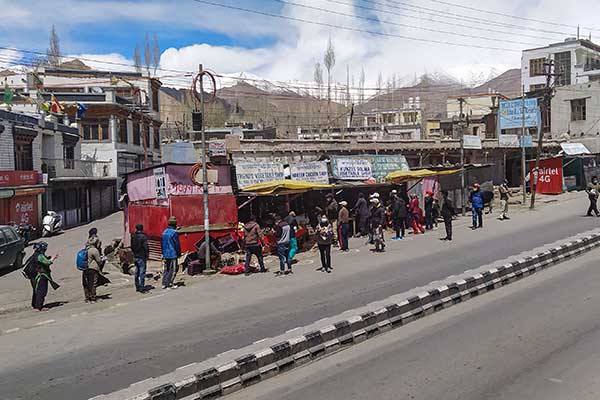A brief history of social distancing in Ladakh and the western Himalayas

Historically, neither infectious diseases nor quarantine are new to Ladakh or the wider Himalayan region. At first sight, this is a depressing topic for research. However, closer examination points to encouraging evidence of human ingenuity. Above all, it reminds us—if any reminder is needed—of the benefits of modern medical care.
Some of the most vivid source material concerns smallpox. Dr Henry Cayley (1834-1904), a member of the Indian Medical Service, was the first fully-trained Western doctor to work in Ladakh: he came to Leh in 1867 as a British ‘officer on special duty’ and ran a clinic alongside his main work, which was to monitor the Central Asian trade routes. He wrote that he saw no case of smallpox in that year but that “ten years ago it spread through the whole country, and killed numbers”. He goes on to explain that the Ladakhis had practised a stark form of social distancing.
He writes, “In former years the custom was to expose the patients with the disease out on the mountain sides, where the friends brought them food, &c. until they either died or got well. It was a somewhat cruel, but, at the same time, admirable, plan for lessening the spread of the disease: and in this climate it would really be better for the sick to be out in the open air, than shut up in a close dwelling.”
On a happier note, he reported that the whole population had been “inoculated by the Lamas” during that period. Since then, the disease had not occurred, except for a few cases in 1866, and the dread of the disease had greatly diminished.
It is not clear precisely what Cayley means by “inoculation”. In the late 18th Century, the British doctor Edward Jenner had pioneered the process of cowpox vaccination. The East India Company veterinarian William Moorcroft, who visited Ladakh in 1820 and 1821, tried to introduce vaccination against smallpox, but was unsuccessful because he was unable to obtain a sufficient quantity of active vaccine from his friends in India. Meanwhile, Lobsang Yongdan has mentioned that Tibetan scholar Jampel Tendzin Trinlé (1789-1839), widely known as ‘Tsenpo’, wrote about vaccination in Jenner’s sense, as early as the 1830s. However, the Ladakhi lamas who were inoculating in the 1850s may have been practising variolation, a procedure in which a healthcare practitioner immunises an individual against smallpox using material taken from a patient in the hope that a mild but protective infection would result from this exposure.
In any case, both Western and local practitioners combined to spread knowledge of Jennerian vaccination in the western Himalayan region from the mid-19 Century onwards.
Another example from 1867, the year that Cayley was writing from Ladakh, concerns the Moravian missionary Eduard Pagell (1820-1883) who served in Pooh, Kinnaur. In February 1867 a messenger from the Totso valley in the neighbouring region of Western Tibet arrived to say that the area was suffering from a smallpox epidemic, which had already wiped out several families.He asked the missionary to come to their aid or no one would be left at all.
Pagell had himself been sick in bed for three days but he duly set out on the five-day journey to Totso. In one village of 23 houses, 60 people had caught the disease and all but a few had died. In another place, those infected by the disease had taken refuge in a cave some distance away—following the same ‘quarantine’ technique as the Ladakhis—where they languished without any care at all. Pagell gave what help he could, visiting 12 villages and vaccinating 639 people.
On this emergency visit, Pagell was welcomed wherever he went and many of his patients recovered but he was never able to repeat the journey. When he tried to do so in the summer of 1867, he found that the Tibetans had broken bridges on the main paths and placed watchmen at the border with orders to shoot anyone who tried to enter the country from Kinnaur; the whole country was in quarantine.
In Ladakh, both the knowledge and the practice of vaccination continued to spread. In 1880, British Joint Commissioner, Ney Elias (1844-1897) wrote about a monk named Sonam Tandup who would collect smallpox vaccines from the British dispensary. He would then travel from place to place for most of the year administering the vaccine. He had conducted 634 vaccinations in 1877, 347 in 1878 and 445 in 1879. He received no salary for his service, and Elias asked his superiors to give Sonam Tandup Rs 15 for his work over the previous year.
Today, we again need to implement quarantine and social distancing but smallpox belongs to the past. One day—we hope soon—COVID-19 will likewise be a distant historical memory.
By John Bray
Photograph by Rigzin Chodon
John Bray is a historian. He is currently based in Singapore.

Nice content ,I use to read all time ,Stawa always took major issue in the form of paper ,….me and my sibling always enjoy Stawa magazine since 7/8 month ….that time….article 370 abolished in j&k ,5 August 2019 to last week of January 2020 no internet at kargil …At that time we had a chance to read this magazine …now we Wait next …
Kasa juley Fatima ley,
We hope to restart the printed magazine once things settle down and continue updating the website too.
regards,